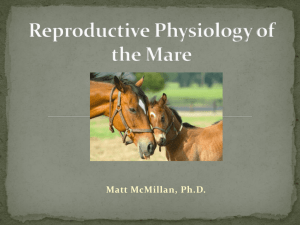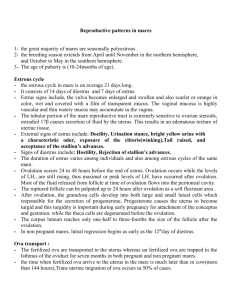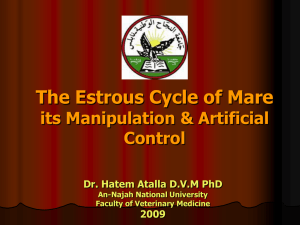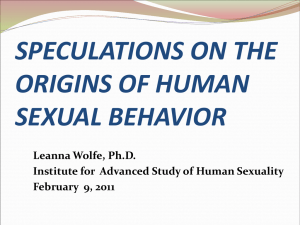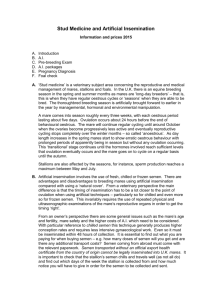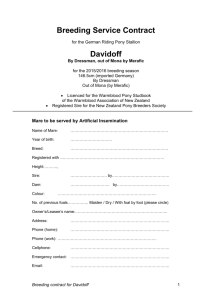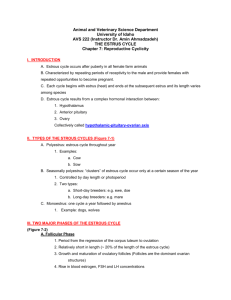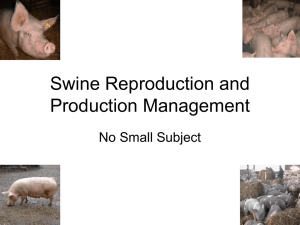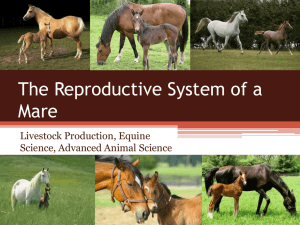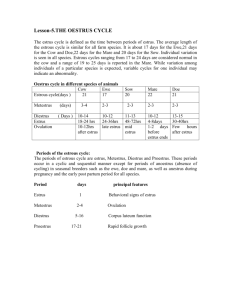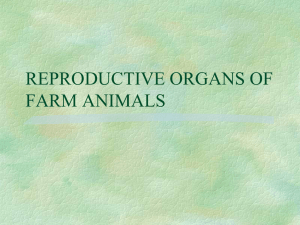Breeding Horses
advertisement
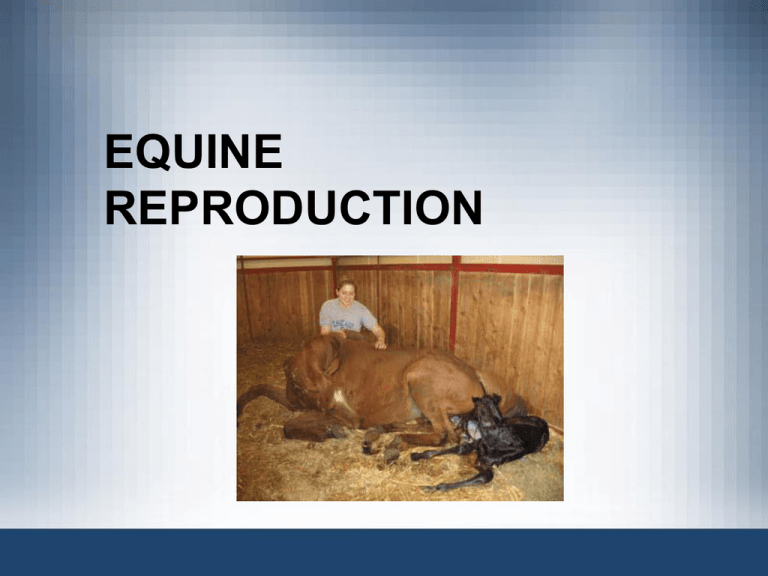
EQUINE REPRODUCTION TERMINOLOGY BOOK BOOKING FEES STUD FEE FOAL GUARANTEE Live Foal Return Color WET/DRY CARE BREEDER Thoroughbred Other breeds DEATH & SALES CLAUSE CHUTE FEE Stallion Physiology Onset of sexual maturity 10-24 mo Life span of sperm in female tract Survival time with fertilizing capacity Sperm output Semen volume/ejaculate Sperm concentration X 106 2-4 days # sperm/ejaculate X 109 6 1-2 days 20-100 ml 30-800 ml Sperm Production • Sperm Output and Production is influenced by: – – – – Season Testicular size Age Frequency of ejaculation – Behavior Number of Sperm Depends On: • Seasonal Influences (Photoperiod) – Effected Areas • • • • • • • • Ejaculate volume Sperm numbers Total sperm/ejaculate Sperm motility Willingness to breed Mounts before breeding Scrotal size Testosterone production Mare Anatomy • • • • • • Vulva Vagina Cervix Uterus Oviducts Ovaries Left Ovary Oviduct Cervix Vagina Left Uterine Horn Uterine Body MARES TERMS • Anestrus • Diestrus • Estrous • Estrus MARE CLASSIFICATION • • • • • • Pregnant Open Barren Maiden Wet Dry The Open Mare • • • Evaluate reproductive history Establish the time of year to breed Mare Plan: – Diagnose possible problems – Implement problem management – Establish estrus calendar Mares Cycle 120 Percent 100 80 60 40 20 0 J F M A M J % Mares ovulating J A S O % Mares in estrus N D Photoperiod Effect • • Reproductive activity in spring is stimulated by an increasing photoperiod Mechanism – Alteration of hormone secretion by the pineal gland and hypothalamus J F M A M J J A S O N D Receptors in eye Neuropathway Neuropathway Pineal gland Decreasing melatonin Increasing melatonin Hypothalamus Increasing GnRH Decreasing GnRH Anterior pituitary Decreasing gonadotropins Increasing gonadotropins Ovaries Transition Period • • Increased photoperiod stimulates the hypothalamus and pituitary Pituitary hormones (especially FSH) induce follicular development Transition • • • • • 1-3 waves of follicles develop & regress Estrogens produced by developing follicles Irregular/prolonged estrus exhibited 1 follicle eventually ovulates Thereafter, mares ovulate at ~21-day intervals •21-day estrous cycle •Estrus 5-7 d •Diestrus 14-16 d Estrous Cycle Sun Mon Tue Wed Thu Fri Sat 1 2 3 4 5 6 7 8 9 10 11 12 13 14 15 16 17 18 19 20 21 22 23 24 25 26 27 28 29 30 31 Estrus Follicular Development & Ovulation • Anterior Pituitary – FSH - follicular growth • Pituitary – LH – maturation of follicle & ovulation • Follicles reach 20-25 mm in diameter, secrete estrogen. Prediction of Ovulation • • Number of days in heat Growth rate of largest follicle – Average 3-5 mm/day • • • Size of largest follicle Softness of preovulatory follicle Ultrasound image Diestrus Corpus Luteum Formation • Corpus luteum secretion of progesterone. • Progesterone responsible for keeping the mare out of heat and for maintaining pregnancy. Prostaglandin Release • Prostaglandin (PGF) released from the uterus of a nonpregnant mare 14-16 days after ovulation Postpartum Estrus • • • • Foal Heat Fertile as compared to other species. Breeding may be necessary to maintain the 12 mo. Foaling interval. May be necessary to back up foaling. Signs of Estrus • Most consistent – Elevated tail raise – Winking • Other supporting signs – Leaning – Squatting – Standing still – Urinating Manipulation Methods Artificial lighting Shortening Late Transition Inducing Ovulation Estrus synchronization Estrus Synchronization & Ovulation Induction Light Stimulus • • 16 hrs daylight per day 30-60 days Progesterone or related compounds Regumate – most common Normalization of estrus Regulation of estrus Estrus synchronization Long-term suppression of estrus Delay foal heat Pregnancy maintenance PGF2 Lutalayse or Estrumate Shorten the interval between estrous periods Treatment of a maintained corpus luteum After foal heat Estrous synchronization with prostaglandins Breeding Methods • • • Pasture Breeding Hand Breeding Artificial Insemination – Fresh semen – Cooled, shipped semen – Frozen semen Cooled Shipped Semen ADVANTAGES • Cost • Genetics • Disease DISADVANTAGES • Cost • Technology/manage ment • Stallion variability Common Problems • Inability to obtain semen • Poor quality semen • Reordering semen • Failure to predict ovulation Frozen Semen • Success of Frozen Semen – Fertility of stallion’s semen – Fertility of the mare – Skill of the veterinarian/technician • Maximum Success – Client communication – Choose ideal candidate – History of stallion Embryo Transfer • • • Synchronization of donor and recipient mare Embryo flushing Embryo transfer procedure TEN FACTORS INFLUENCING PREGNANCY & PREGNANCY LOSS PER CYCLE MARE AGE BARREN REPRODUCTIVE STATUS EARLY BREEDING DATE LATE BREEDING DATE BREEDING FREQUENCY PROSTAGLANDIN FACTOR UTERINE CULTURE & CYTOLOGY EFFECT OF SEMEN EXTENDER POST-BREEDING ANTIBIOTIC INFUSIONS TWINS Pregnancy Evaluation • • • Ultrasound, 14-18 days – ID twins – ID placental development Re-evaluate, 40 days Monitor Placental function & fetal growth Gestation Length • Normal: 335-342 days GROWTH CURVE 140 120 CR in cm 100 80 60 40 20 0 20 60 100 140 190 Gestation age in days 260 340 Late Pregnancy • • • • • • • Abdomen greatly enlarged Ventral edema Mammary gland enlargement – 2-4 wk Gluteal muscles relax – 7-10 d Teats fill with milk – 4-7 d Waxing of teat ends – 1-4 d Vulva soft & relaxed – 1-2 d Stages of Parturition • Stage 1 – Onset: initial uterine contractions – End: rupture of chorioallantois (water bag) • Stage 2 – Onset: rupture of chorioallantois – End: delivery of fetus Stages of Parturition • Stage 3 (< 3 hrs) – Onset: delivery of fetus – End: passage of the fetal membranes Foals and Immunity • • • • Colostrum (first milk) antibodies 1-2 pts of high quality colostrum If adequate passive transfer occurs there will be over 400-800 mg/dl IgG in foal’s blood Takes ~ 12 hours for all antibodies ingested in colostrum to show up in the blood Key points • • • • First two weeks- lay the groundwork by ensuring adequate colostrum Preventative health program in place Appropriate nutrition Problems must be addressed rapidly when they arise. No time for a “wait and see” attitude
